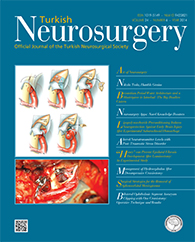2Hacettepe University, School of Medicine, Department of Anatomy, Ankara, Turkey
3Hacettepe University, School of Medicine, Department of Radiology, Ankara, Turkey DOI : 10.5137/1019-5149.JTN.9785-13.2 AIM: We aimed to examine the basilar artery in an experimental subarachnoid hemorrhage (SAH) model both from the ultrastructural and radiological aspects and tried to evaluate the benefit of proanthocyanidin (PC), an antioxidant matter, in reducing vasospasm.
MATERIAL and METHODS: A total of 21 male New Zealand rabbits were divided into three groups after performing angiography. Group I: Control group, Group II: Subarachnoid hemorrhage group, Group III: Subarachnoid hemorrhage and Proanthocyanidin group (100 mg/kg/ day). Rabbits were sacrificed on the 5th day after angiography. A segment of the basilar artery, 4 mm in length, was prepared for ultrastructural examination.
RESULTS: There was no ultrastructural or radiological abnormality in the basilar artery in Group 1. In the basilar artery digital subtraction angiography (DSA) of Group 2, a statistically significant decrease in basilar artery calibration was found (p<0.05). There was no damage in the endothelium, subendothelium, tunica media and adventitia of the basilar artery ultrastructurally but a statistically significant narrowing in lumen diameter was seen. There was also no difference in basilar artery calibration in the DSA of Group 3 (p>0.05). No damage was seen in the basilar artery ultrastructurally.
CONCLUSION: Proanthocyanidin with its strong antioxidant effect and possible vasomotor action can significantly attenuate SAH-induced vasospasm.
Keywords : Subarachnoid hemorrhage, Cerebral vasospasm, Proanthocyanidin, Rabbit




